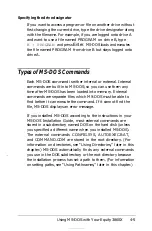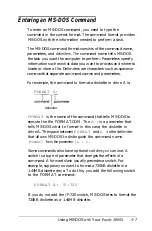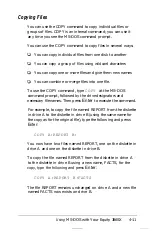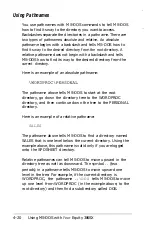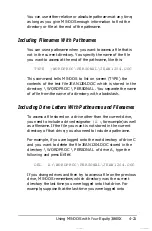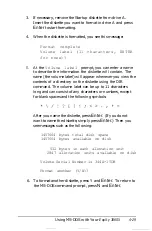
Directories are essential for organizing files on a hard disk, and
you might even want to create directories on a 1.44MB diskette.
However, you may not need to create directories if you use
lower capacity diskettes-especially if the diskette contains only
a few large files.
Whenever you format a disk, MS-DOS automatically creates
one main directory. This directory is called the root directory.
Any directories you later create are logically subordinate to the
root directory; that is, they are subdirectories of the root
directory. Here is an example of a simple directory structure:
Root directory
WORDPROC
DOS
SPDSHEET
In this example, you keep your word processing programs and
data files in a directory called WORDPROC, your spreadsheet
programs and data files in a directory called SPDSHEET, and
MS-DOS files in a directory called DOS. The few files that
MS-DOS needs to find as soon as you turn on your computer
(such as COMMAND.COM, CONFIG.SYS, and
AUTOEXEC.BAT) remain in the root directory at the top
level of the structure.
As the number of files in your WORDPROC and SPDSHEET
directories grows, you can create additional directories
subordinate to those two-like this:
Root directory
WORDPROC
DOS
SPDSHEET
I
I
I
I
BUSINESSPERSONAL
SALES PROJ
Using MS-DOS with Your Equity 386SX
4-17
Summary of Contents for Equity 386SX PLUS
Page 1: ...m u cl3 0 z E 5 J I 1 al y 8 c 7 5 w ii u l X ...
Page 4: ...EPSON E Q U I T Y 3 8 6 S X User s Guide Y19299100100 ...
Page 20: ...6 Introduction ...
Page 38: ...1 18 Setting Up Your System ...
Page 69: ......
Page 70: ...2 32 Running the Setup Program ...
Page 96: ... 7 R _ ri h 14 3 26 Using the Equity 386SX ...
Page 168: ...5 26 dling Options ...
Page 192: ...B 4 Power on Diagnostics ...
Page 232: ...C 40 Performing System Diagnostics ...
Page 246: ... D 14 Physically Formatting a Hard Disk ...
Page 250: ...E 4 Hard Disk Drive Types ...
Page 282: ...8 I n d e x ...
Page 284: ......



